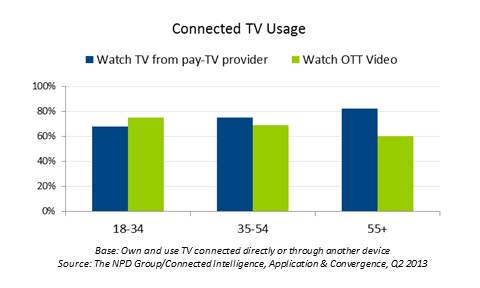Network broadcasts, cable TV, DVR, on-demand, mobile apps, or apps on your TV? Who needs so many ways to watch TV? Me.
Looking at recent viewing behaviors in our home many of these served a purpose, but there is a clear migration towards apps on the TV. The current season of Sons of Anarchy was watched via DVR, all five seasons of The Wire using HBOGO, reams of children’s shows through Netflix, and broadcast/cable TV for my wife’s pop culture viewing addiction, oh yes, Vanderpump Rules.
My technology habits only occasionally become mass market behaviors and I doubt the majority of viewers will find themselves toggling between seven connected TV and attached content devices. But viewer’s habits are rapidly changing, including the use of apps on the TV, just look at the growth in Netflix or Hulu Plus subscribers.
If you were reading this blog a few years ago, it would have been about the trend towards time-shifting using a DVR and its impact on advertising during TV broadcasts. As DVR has become one of many tools in the box, today we’re wrestling with how apps on the TV will integrate into the viewing experience. With all of the other options for watching network and cable programming on TV is there a place for the network app? If you use apps such as HBOGO or Watch Disney Channel then you are already starting to see the transformation in viewing habits. Truth be told; it’s apps on the TV that magnified my viewing time. It’s also marked a transition away from broadcast, cable, and DVR viewing.
In the Connected Home Forecast report published this week we surmised these trends will perpetuate and at a more rapid pace than previously expected. By 2015, it’s estimated that 202 million devices will be installed and capable of delivering apps to the TV. And, compared to only six months ago, more consumers are buying smart TVs and using them for their apps. This led us to start thinking; what does it mean for networks building apps for the TV? Hurry, rush, hustle, and get in the game.
TV Everywhere goes well beyond a mobile app strategy; it’s about having a TV app strategy as well. And, that means understanding which devices consumers will be using to get apps on their TVs. The migration to using apps instead of linear, on-demand, and DVR pay TV programming is already underway, and it’s most prominent with consumers age 18-34. In the chart below, over-the-top (OTT) video is not just Netflix and YouTube viewing, it’s network apps such as HBOGO too. These apps often offer a different viewing experience, one we’re finding is very attractive to consumers as it can open up a network’s full library of TV shows, line-up of moves, additional and exclusive footage, etc.

So, how do you watch TV?
The answer to that question will inevitably be different in the coming months and years. If history has taught us anything the simplest solution that delivers what consumers want most, will be successful.
Currently, the challenge resides on the device side. The average American already has about two connected TV devices in their home, and that number is growing, suggesting a simple and common user-interface will foster greater usage. In that regard it’s not surprising that Chromecast has seen early successas it could be said they nailed simplicity by doing away with a user interface entirely.
On the content side, apps are being developed for numerous device platforms. Some network apps will survive, other will wallow in obscurity. What’s the formula for success? We’re about to conduct new research to find out. Do viewers want AMC’s entire library of shows, ad-free viewing from CBS, apps that make shows available concurrent with the TV broadcast, exclusive episodes, or are they more interested in apps being an extension of the broadcast viewing experience?
Stay tuned and we’ll let you know what viewers have to say.


